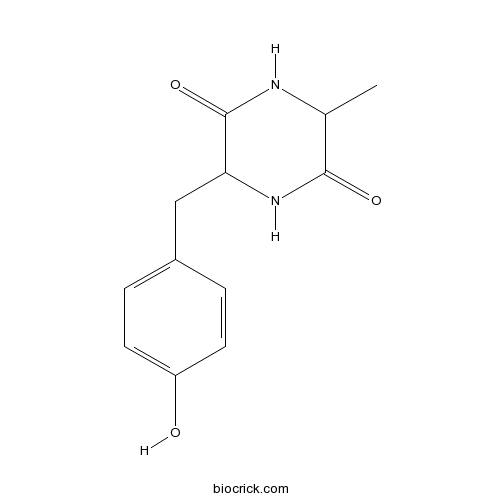Cyclo(Ala-Tyr)CAS# 21754-26-7 |

Quality Control & MSDS
3D structure
Package In Stock
Number of papers citing our products

| Cas No. | 21754-26-7 | SDF | Download SDF |
| PubChem ID | 571964 | Appearance | Powder |
| Formula | C12H14N2O3 | M.Wt | 234.25 |
| Type of Compound | Miscellaneous | Storage | Desiccate at -20°C |
| Solubility | Soluble in Chloroform,Dichloromethane,Ethyl Acetate,DMSO,Acetone,etc. | ||
| Chemical Name | 3-[(4-hydroxyphenyl)methyl]-6-methylpiperazine-2,5-dione | ||
| SMILES | CC1C(=O)NC(C(=O)N1)CC2=CC=C(C=C2)O | ||
| Standard InChIKey | MFUNIDMQFPXVGU-UHFFFAOYSA-N | ||
| Standard InChI | InChI=1S/C12H14N2O3/c1-7-11(16)14-10(12(17)13-7)6-8-2-4-9(15)5-3-8/h2-5,7,10,15H,6H2,1H3,(H,13,17)(H,14,16) | ||
| General tips | For obtaining a higher solubility , please warm the tube at 37 ℃ and shake it in the ultrasonic bath for a while.Stock solution can be stored below -20℃ for several months. We recommend that you prepare and use the solution on the same day. However, if the test schedule requires, the stock solutions can be prepared in advance, and the stock solution must be sealed and stored below -20℃. In general, the stock solution can be kept for several months. Before use, we recommend that you leave the vial at room temperature for at least an hour before opening it. |
||
| About Packaging | 1. The packaging of the product may be reversed during transportation, cause the high purity compounds to adhere to the neck or cap of the vial.Take the vail out of its packaging and shake gently until the compounds fall to the bottom of the vial. 2. For liquid products, please centrifuge at 500xg to gather the liquid to the bottom of the vial. 3. Try to avoid loss or contamination during the experiment. |
||
| Shipping Condition | Packaging according to customer requirements(5mg, 10mg, 20mg and more). Ship via FedEx, DHL, UPS, EMS or other couriers with RT, or blue ice upon request. | ||
| Description | Cyclo(Val-Tyr) is a product from the culture of Pseudomonas putida. |
| Structure Identification | Wei Sheng Wu Xue Bao. 2013 Aug 4;53(8):825-31.Anti-diatom compounds from marine bacterium Pseudomonas putida.[Pubmed: 24341274] In order to provide more natural antifouling compounds, marine bacterium Pseudomonas putida isolated from the sponge Haliclona sp. was explored to test its anti-diatom compounds. |

Cyclo(Ala-Tyr) Dilution Calculator

Cyclo(Ala-Tyr) Molarity Calculator
| 1 mg | 5 mg | 10 mg | 20 mg | 25 mg | |
| 1 mM | 4.2689 mL | 21.3447 mL | 42.6894 mL | 85.3789 mL | 106.7236 mL |
| 5 mM | 0.8538 mL | 4.2689 mL | 8.5379 mL | 17.0758 mL | 21.3447 mL |
| 10 mM | 0.4269 mL | 2.1345 mL | 4.2689 mL | 8.5379 mL | 10.6724 mL |
| 50 mM | 0.0854 mL | 0.4269 mL | 0.8538 mL | 1.7076 mL | 2.1345 mL |
| 100 mM | 0.0427 mL | 0.2134 mL | 0.4269 mL | 0.8538 mL | 1.0672 mL |
| * Note: If you are in the process of experiment, it's necessary to make the dilution ratios of the samples. The dilution data above is only for reference. Normally, it's can get a better solubility within lower of Concentrations. | |||||

Calcutta University

University of Minnesota

University of Maryland School of Medicine

University of Illinois at Chicago

The Ohio State University

University of Zurich

Harvard University

Colorado State University

Auburn University

Yale University

Worcester Polytechnic Institute

Washington State University

Stanford University

University of Leipzig

Universidade da Beira Interior

The Institute of Cancer Research

Heidelberg University

University of Amsterdam

University of Auckland

TsingHua University

The University of Michigan

Miami University

DRURY University

Jilin University

Fudan University

Wuhan University

Sun Yat-sen University

Universite de Paris

Deemed University

Auckland University

The University of Tokyo

Korea University
- Cyclo(Tyr-Val)
Catalog No.:BCN2413
CAS No.:21754-25-6
- Tulathromycin A
Catalog No.:BCC2019
CAS No.:217500-96-4
- L-817,818
Catalog No.:BCC7221
CAS No.:217480-27-8
- L-803,087 trifluoroacetate
Catalog No.:BCC7220
CAS No.:217480-26-7
- Lucidumol A
Catalog No.:BCN8270
CAS No.:217476-73-8
- 1-Hydroxy-2-oxopomolic acid
Catalog No.:BCN4931
CAS No.:217466-37-0
- (±)-J 113397
Catalog No.:BCC7423
CAS No.:217461-40-0
- SB 268262
Catalog No.:BCC7916
CAS No.:217438-17-0
- 5-Methoxyresorcinol
Catalog No.:BCN6904
CAS No.:2174-64-3
- 5-O-Demethylnobiletin
Catalog No.:BCN2958
CAS No.:2174-59-6
- Spectinomycin dihydrochloride
Catalog No.:BCC5166
CAS No.:21736-83-4
- Aristoliukine B
Catalog No.:BCN8096
CAS No.:217310-32-2
- Taxoquinone
Catalog No.:BCN6660
CAS No.:21764-41-0
- BX 471
Catalog No.:BCC6029
CAS No.:217645-70-0
- 4-Cadinen-7-ol
Catalog No.:BCN4932
CAS No.:217650-27-6
- H-Asp(OBzl)-OH
Catalog No.:BCC2885
CAS No.:2177-63-1
- 9,16-Dioxo-10,12,14-octadecatrienoic acid
Catalog No.:BCN1490
CAS No.:217810-46-3
- Curcolonol
Catalog No.:BCN3558
CAS No.:217817-09-9
- Diallyl disulfide
Catalog No.:BCN3840
CAS No.:2179-57-9
- Homomangiferin
Catalog No.:BCN8145
CAS No.:21794-66-1
- Noroxyhydrastinine
Catalog No.:BCN2646
CAS No.:21796-14-5
- Thalifoline
Catalog No.:BCN3301
CAS No.:21796-15-6
- Potassium Canrenoate
Catalog No.:BCC3844
CAS No.:2181-04-6
- Isopteleine
Catalog No.:BCN7067
CAS No.:2181-84-2
[Anti-diatom compounds from marine bacterium Pseudomonas putida].[Pubmed:24341274]
Wei Sheng Wu Xue Bao. 2013 Aug 4;53(8):825-31.
OBJECTIVE: In order to provide more natural antifouling compounds, marine bacterium Pseudomonas putida isolated from the sponge Haliclona sp. was explored to test its anti-diatom compounds. METHODS: The strain was identified by colonial morphology, scanning electron microscope (SEM) and 16S rDNA sequence analysis. The separation procedure was guided by bioactive (Anti-diatom) and chemical (TLC, DAD-HPLCand 1H NMR) analysis, and their structures were elucidated by spectrographic techniques. The anti-diatom activity of all purified compounds was assayed. RESULTS: Strain 272 isolated from the sponge Haliclona sp. was identified as Pseudomonas putida. Six diketopiperazine compounds were isolated from the culture of this strain and their structures were determined as cyclo(Leu-Pro) (1), cyclo (Leu-Ala) (2), cyclo(Phe-Ala) (3), cyclo(Val-Tyr) (4), Cyclo(Ala-Tyr) (5), cyclo(Ala-Trp) (6); Compounds 3 and 6 displayed significant anti-diatom activity with the inhibitory rate of 50% and 85% at the concentration of 50 microg/mL, respectively. CONCLUSION: The anti-diatom compounds isolated from marine bacterium Pseudomonas putida were cyclo (Phe-Ala) and cyclo (Ala-Trp).


